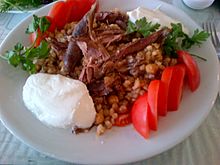Keşkek facts for kids
Quick facts for kids Ceremonial Keşkek tradition, Keške |
|
|---|---|
|
UNESCO Intangible Cultural Heritage
|
|

A Keşkek meal from Tokat, Turkey
|
|
| Country | Turkey |
| Reference | 388 |
| Region | Europe and North America |
| Inscription history | |
| Inscription | 2011 (6th session) |
Keşkek is a special kind of stew. It's made with meat (like beef or chicken) and grains like wheat or barley. This tasty dish is popular in countries like Turkey, Iran, Greece, and the Balkans. It's often served at important events and celebrations.
In 2011, a group called UNESCO officially recognized Keşkek as an "Intangible Cultural Heritage" of Turkey. This means it's a very important tradition that should be protected and celebrated.
The Story of Keşkek
Keşkek has a long history! The first time anyone wrote about this dish was in a book from around the year 1360. People were eating it in Iran and a region called Greater Syria as early as the 1400s. Many Iranians still enjoy it today.
Keşkek is thought to be connected to an older dish called Kashk. In the past, Kashk was made with sheep's milk, wheat or barley flour, and meat.
Keşkek at Special Events
Keşkek is a very old tradition. In Turkey, it's often a main dish at wedding celebrations. It's a way to bring people together.
In Greece, especially on the island of Lesbos and among people called Pontian Greeks, Keşkek is a special festival food. Sometimes, it's prepared on summer nights when a ceremonial bull is cooked slowly overnight. Then, people eat it the next day with wheat.
In some parts of Turkey, like Northeast and Middle Anatolia, Keşkek is called "haşıl." It's a common dish there. Just like in Iran, people often eat Keşkek during religious festivals, weddings, or even funerals.
Keşkek's Relatives
Keşkek is similar to a dish called Harees in Armenia. Harissa is made in a very similar way to Keşkek. However, these two dishes have different special meanings for the people who eat them.
See also
 In Spanish: Keşkek para niños
In Spanish: Keşkek para niños

